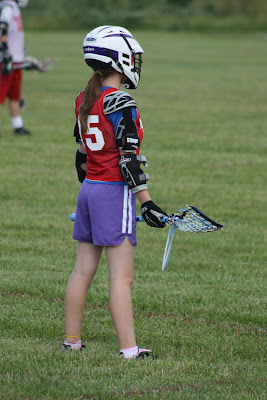From
Baby Blues by Rick Kirkman and Jerry Scott:

"Where were their mothers?" Iroquois moms could be found on the sidelines, cheering on their sons (always sons back in the day), and most likely betting on the game. Taboos against wagering on sports, to the extent that such taboos exist, are a purely Western convention.
On the rampage at lastBack in the autumn, I took a sabbatical from coaching the
Lincoln Rampage lacrosse team in order to concentrate on my falconry. (Which worked out, more or less.) At the same time, my coaching partner, Greg McManus, decided to step down as head coach and assume a more administrative role with the club. The team hired former Nebraska Cornhuskers coach Nate Hoeckelmann to fill our shoes, and things have worked out well.
Nate has coached at the high school and college level for over ten years, and brings not just Xs and Os but also more discipline: he really knows how to run a practice and make the best use of the available time. And, as Greg and I had foreseen, the kids have now come into their own: led by a couple of seniors and a large crop of juniors (and backed by a brilliant freshman goalie in Will Ehrman), they now have the confidence that they belong on the lacrosse field. As of right now, they are 11-2 and
ranked #1 in the state by West Side Lacrosse, with one more regular-season game to go before the playoffs start next weekend.
I've attended several of the Rampage's games, and it's wonderful to see them playing so well and winning games, an accomplishment that eluded us for so long. But if I'm honest, it's difficult as well: why couldn't they play like this when Greg and I were coaching? I suppose we will have to content ourselves with the knowledge that ours was a younger, less-experienced team, and with Nate's assurances that the present team's success is laid on the foundation that we built. We started the program from scratch, taught the fundamentals, and (I hope) instilled a love of the game that will last.
Meanwhile, I've not given up coaching altogether. The next frontier: girls' lacrosse in Lincoln. I've been asked by the club to coach a girls' team at the high-school level; we didn't have enough players to field a team this spring (which is probably just as well, considering how busy I've been), but we'll try again next year. And I'll be somewhat involved in youth lacrosse as well...
The pipelineThe quality of high-school lacrosse in the area depends largely on youth programs to teach the sport to younger kids. We hope to resurrect youth lacrosse in Lincoln this fall; meanwhile, Ellie and her friend Amelia are playing up in Omaha again. A few photos from last season follow.
[Ellie: game face]

[Going for the ground ball...]

[...and winning it]

[On the wing, awaiting faceoff]

[Sportsmanship]

[Postgame: Ellie and Amelia]
 You heard it here first
You heard it here firstLast May, writing about my favorite
Major League Lacrosse team, I referred to them as "the Baltimore-then-Washington-but-now-playing-in-Annapolis-so-let's-just-call-them-Maryland-or-maybe-Chesapeake-Bayhawks". I don't know if someone with the organization was reading Flyover Country or not, but they are now officially...the
Chesapeake Bayhawks.
The itinerant Hawks have struggled to draw crowds in a lacrosse-saturated market. Their first
home venue was Homewood Field at Johns Hopkins University (I attended their first game, which was also the league's opening game); subsequent home fields have included M&T Bank Stadium (home of the NFL's Ravens) in Baltimore as well as on-campus venues at Towson University, George Mason University, and Georgetown University. They are now in the second year of a three-year contract with Navy-Marine Corps Memorial Stadium at the US Naval Academy in Annapolis. According to
Lacrosse Magazine, the team's new management deliberately adopted a regional approach: "If you don't include any of those cities, you alienate somebody immediately, " says Bayhawks president Brendan Kelly. "We wanted to encompass the whole market. The Chesapeake Bayhawks. It was really a no-brainer, kind of a play off the New England Patriots."
Mr. Kelly, I hope the new strategy (which includes youth clinics and alumni games between local college rivals) pays dividends. I'll do my best to make it to at least one game this summer. And if you
did get the idea for the new name here, there's no charge. I'm just happy to be part of the team...
Wrapping upYes, the
Salt Creek Tiger Beetles will be back this summer. More to follow (eventually), so check back.







